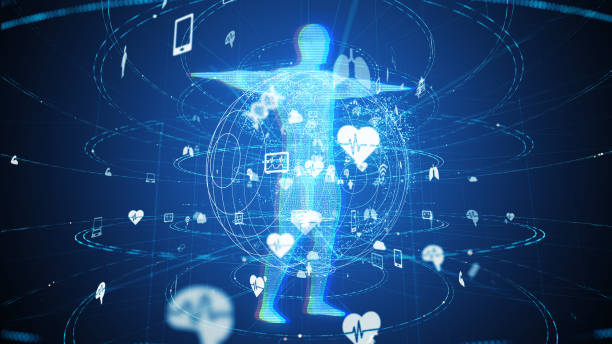Explore the Evolution of Wearable Technology in Healthcare. From continuous monitoring to AI-driven diagnostics, discover how wearables are transforming the future of personalized health and well-being.
The evolution of wearable medical devices represents a remarkable journey from the rudimentary fitness trackers of the past to the sophisticated, life-changing technology we have today. This subheading delves into the history and progress of wearable devices in the medical field, showcasing how they have transformed healthcare.
Historical Context:
Wearable technology in healthcare has roots dating back to the 16th century when the first stethoscope was invented. However, the real transformation began in the late 20th century with the advent of portable ECG monitors and insulin pumps. These early devices laid the foundation for what we have today.
The Role of Miniaturization:
A key driver of the evolution has been miniaturization. Advances in electronics and material science have allowed for the development of smaller, more comfortable, and less intrusive wearable devices. This progress has made it possible to monitor an array of health parameters without the inconvenience of traditional hospital equipment.
From Basic Tracking to Advanced Monitoring:
Early wearable devices primarily focused on basic tracking, like step counting and heart rate monitoring. Today, wearable technology encompasses a wide spectrum of applications, from monitoring vital signs like blood pressure, glucose levels, and oxygen saturation to ECG monitoring, sleep tracking, and even early cancer detection.
Integration with Smart Technology:
Wearable medical devices have seamlessly integrated with smart technology, allowing users to access their health data through smartphones and tablets. This connectivity has not only made the data more accessible but has also enabled users to share their health information with healthcare providers in real-time.
Clinical Validation:
One significant aspect of the evolution has been the increasing clinical validation of wearable devices. As these technologies became more advanced, healthcare professionals and researchers began to recognize their potential. Wearable ECG monitors, for instance, are now considered reliable tools for diagnosing arrhythmias, thanks to years of clinical studies.
User-Centered Design:
Modern wearable medical devices are not only technologically advanced but also user-centered in design. They are comfortable, unobtrusive, and often aesthetically pleasing. This approach encourages more people to incorporate these devices into their daily lives, making healthcare monitoring a routine practice.
The Impact on Healthcare Delivery:
The evolution of wearable medical devices has not only transformed individual health monitoring but also healthcare delivery as a whole. These devices have become indispensable in telemedicine, remote patient monitoring, and early intervention, especially during the COVID-19 pandemic.
Real-Time Health Monitoring in Wearable Technology
Wearable technology has ushered in an era of real-time health monitoring that is transforming the way we track and manage our well-being. This subheading delves into the intricate details of how wearable medical devices are revolutionizing the healthcare landscape through continuous, on-the-go monitoring of vital signs and health parameters.
Wearable devices equipped with sophisticated sensors have made it possible to monitor critical health indicators in real-time, providing individuals with immediate insights into their physical condition. This level of instantaneous data acquisition has far-reaching implications for early disease detection, chronic condition management, and overall health optimization.
Continuous Vital Sign Tracking:
Wearable devices can continuously track a wide array of vital signs, including heart rate, blood pressure, oxygen saturation, and even electrocardiogram (ECG) readings. These devices are equipped with sensors that securely and unobtrusively collect data as users go about their daily lives.
The information gathered from these continuous monitoring activities is invaluable for detecting irregularities or anomalies in vital signs. For instance, sudden spikes in heart rate or blood pressure can be indicative of a potential health issue. Such real-time alerts can prompt users to seek medical attention promptly, potentially preventing more severe health complications.
Personalized Health Insights:
One of the remarkable aspects of real-time health monitoring is the generation of personalized health insights. Wearable devices are often synchronized with smartphone apps or cloud-based platforms that process the collected data. These platforms use advanced algorithms to provide users with tailored health recommendations and insights.
For example, a wearable fitness tracker may not only monitor your daily steps but also offer advice on how to improve your activity levels. Likewise, wearable ECG monitors can help individuals understand their heart health, offering guidance on managing stress or maintaining optimal heart rates.
Healthcare Provider Access:
Real-time health monitoring isn’t limited to personal use; it has also transformed the way healthcare providers interact with patients. Through secure connections, patients can grant their doctors access to their wearable device data, allowing for remote monitoring.
This level of connectivity has been particularly valuable during the COVID-19 pandemic when in-person visits were limited. Patients with chronic conditions can receive ongoing care, and doctors can identify issues and adjust treatment plans promptly.
Diagnosis and Disease Management
Wearable technology has emerged as a game-changer in the field of healthcare, especially when it comes to the early diagnosis and effective management of diseases. This subheading delves into the significant impact of wearable devices in the realm of diagnosis and disease management, highlighting their roles in improving patient outcomes and transforming the healthcare landscape.
Early Detection and Timely Intervention
Wearable medical devices equipped with advanced sensors have the capability to detect health anomalies at their incipient stages. For instance, continuous glucose monitoring devices are invaluable for individuals with diabetes. They offer real-time data on blood glucose levels, enabling users and healthcare professionals to take proactive measures to manage the condition. This early detection can prevent severe complications and improve the quality of life for patients.
Managing Chronic Conditions
Chronic diseases, such as hypertension and cardiovascular conditions, require continuous monitoring. Wearable devices designed for disease management provide patients with a means to track their health parameters on an ongoing basis.
These devices offer immediate feedback on vital signs like blood pressure, heart rate, and ECG readings, enabling individuals to take control of their health. They also allow healthcare providers to make data-driven decisions for more effective treatment plans.
Remote Monitoring
The ability to remotely monitor patients is a crucial aspect of modern healthcare, especially in the context of global health crises, such as the COVID-19 pandemic. Wearable technology supports telemedicine and remote patient monitoring, facilitating healthcare services from a distance. Patients can stay connected with their healthcare providers through these devices, making it easier to manage their health, particularly for those in remote or underserved areas.
Personalized Treatment Plans
Wearable devices generate vast amounts of data, which, when processed and analyzed, can provide insights into an individual’s health trends and patterns. This information is instrumental in creating personalized treatment plans. For example, patients with heart conditions can benefit from wearable ECG monitors that continuously record their heart rhythms. This data enables healthcare providers to tailor treatment regimens, adjusting medications and interventions in real time based on the patient’s specific needs.
Enhancing Quality of Life
Beyond the clinical aspects, wearable technology enhances the overall quality of life for patients. Prosthetic limbs with embedded sensors offer better mobility and functionality, allowing individuals to lead more active lives. Smart glasses assist those with visual impairments in various daily tasks, such as reading and navigation, thus increasing independence.
Improving the Quality of Life
This section of the article delves into how wearable technology in the medical field has been instrumental in enhancing the overall quality of life for individuals. It highlights various applications and devices that not only address medical concerns but also empower patients to lead more fulfilling and independent lives.
The discussion includes innovative solutions for physical disabilities, visual impairments, and technologies that support mental health and well-being. Wearable devices are not limited to diagnosing and managing medical conditions; they contribute to the holistic improvement of patients’ daily lives and overall well-being.
Mental Health and Well-Being
Development of Wearable Technology in the Medical Field delves into the impact and applications of wearable technology in the context of mental health and overall well-being. It focuses on how wearable devices have evolved to monitor and support individuals in managing their mental health and improving their general sense of well-being.
Under this subheading, the article would likely discuss the following:
- Mental Health Monitoring: Wearable devices equipped with sensors and algorithms that can detect signs of stress, anxiety, or depression in users. These devices may track physiological markers like heart rate variability, skin conductance, or even voice patterns to assess mental health.
- Biofeedback and Stress Management: How wearables offer real-time biofeedback to help individuals manage stress and anxiety. For example, they might provide guided breathing exercises or suggest relaxation techniques based on the user’s physiological data.
- Sleep Tracking: Many wearable devices now monitor sleep patterns and offer insights into sleep quality. Poor sleep can significantly affect mental health, and these devices help users identify and address sleep-related issues.
- Support for Mental Health Conditions: Discussing how wearables can provide ongoing support for individuals with conditions like anxiety or depression. They might offer reminders for medication, therapy appointments, or encourage physical activity, all of which can positively impact mental health.
- Well-Being and Lifestyle Enhancement: How wearable technology goes beyond illness management and contributes to an individual’s overall sense of well-being. This might include tracking daily activity levels, encouraging physical fitness, and promoting a healthier lifestyle.
This subheading highlights the crucial role that wearable technology plays in addressing mental health challenges and supporting individuals in their quest for improved well-being. It showcases the broader, holistic impact of these devices beyond just physical health monitoring.
Conclusion
The development of wearable technology in the medical field is nothing short of revolutionary. These innovative devices have redefined the way we approach healthcare, from real-time monitoring of vital signs to the management of chronic conditions. They have made telemedicine and remote patient monitoring not just a possibility but a practical and accessible reality.
Wearable technology is not limited to physical health; it also addresses mental well-being, helping individuals manage stress and improve their quality of life. As we move forward, the potential for even more groundbreaking developments in this field is immense, with the promise of non-invasive diagnostics, early disease detection, and novel drug delivery methods.
However, as this technology continues to advance, we must remain mindful of ethical and privacy considerations. Ensuring the responsible use of personal health data and protecting patients’ rights is paramount.
In closing, wearable technology has not only transformed the medical field but has also empowered individuals to take charge of their health and well-being. It represents a bright future where healthcare is not just more effective but also more accessible and patient-centric. As we embrace these innovations, we do so with the anticipation of an even healthier and more connected world.



